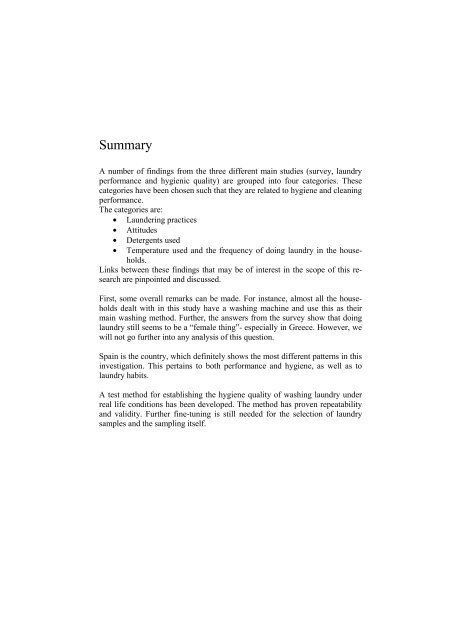an investigation of domestic laundry in europe - habits ... - SIFO
an investigation of domestic laundry in europe - habits ... - SIFO an investigation of domestic laundry in europe - habits ... - SIFO
8An investigation into the domestic laundry habits in EuropeLiterature .......................................................................................................113Appendix A Survey of domestic laundry habits in europe,the questionnaire....................................................................117Appendix B Declaration detergents.............................................................123Appendix C Settings of the 15°C Wascator washing programmefor the hygiene tests ...............................................................127Appendix D Settings of the 30°C Wascator washing programme ..............129
SummaryA number of findings from the three different main studies (survey, laundryperformance and hygienic quality) are grouped into four categories. Thesecategories have been chosen such that they are related to hygiene and cleaningperformance.The categories are:• Laundering practices• Attitudes• Detergents used• Temperature used and the frequency of doing laundry in the households.Links between these findings that may be of interest in the scope of this researchare pinpointed and discussed.First, some overall remarks can be made. For instance, almost all the householdsdealt with in this study have a washing machine and use this as theirmain washing method. Further, the answers from the survey show that doinglaundry still seems to be a “female thing”- especially in Greece. However, wewill not go further into any analysis of this question.Spain is the country, which definitely shows the most different patterns in thisinvestigation. This pertains to both performance and hygiene, as well as tolaundry habits.A test method for establishing the hygiene quality of washing laundry underreal life conditions has been developed. The method has proven repeatabilityand validity. Further fine-tuning is still needed for the selection of laundrysamples and the sampling itself.
- Page 1: • • • • • • • • •
- Page 4 and 5: 2An investigation into the domestic
- Page 6 and 7: 4An investigation into the domestic
- Page 8 and 9: 6An investigation into the domestic
- Page 12 and 13: 10An investigation into the domesti
- Page 14 and 15: 12An investigation into the domesti
- Page 16 and 17: 14An investigation into the domesti
- Page 18 and 19: 16An investigation into the domesti
- Page 21 and 22: 2 Assessment of the consumer laundr
- Page 23 and 24: Assessment of the consumer laundry
- Page 25 and 26: Assessment of the consumer laundry
- Page 27 and 28: Assessment of the consumer laundry
- Page 29 and 30: Assessment of the consumer laundry
- Page 31 and 32: Assessment of the consumer laundry
- Page 33 and 34: Assessment of the consumer laundry
- Page 35 and 36: Assessment of the consumer laundry
- Page 37 and 38: Assessment of the consumer laundry
- Page 39 and 40: Assessment of the consumer laundry
- Page 41 and 42: Assessment of the consumer laundry
- Page 43 and 44: Assessment of the consumer laundry
- Page 45 and 46: Assessment of the consumer laundry
- Page 47 and 48: Assessment of the consumer laundry
- Page 49 and 50: Assessment of the functional perfor
- Page 51 and 52: Assessment of the functional perfor
- Page 53 and 54: Assessment of the functional perfor
- Page 55 and 56: Assessment of the functional perfor
- Page 57: Assessment of the functional perfor
SummaryA number <strong>of</strong> f<strong>in</strong>d<strong>in</strong>gs from the three different ma<strong>in</strong> studies (survey, <strong>laundry</strong>perform<strong>an</strong>ce <strong>an</strong>d hygienic quality) are grouped <strong>in</strong>to four categories. Thesecategories have been chosen such that they are related to hygiene <strong>an</strong>d cle<strong>an</strong><strong>in</strong>gperform<strong>an</strong>ce.The categories are:• Launder<strong>in</strong>g practices• Attitudes• Detergents used• Temperature used <strong>an</strong>d the frequency <strong>of</strong> do<strong>in</strong>g <strong>laundry</strong> <strong>in</strong> the households.L<strong>in</strong>ks between these f<strong>in</strong>d<strong>in</strong>gs that may be <strong>of</strong> <strong>in</strong>terest <strong>in</strong> the scope <strong>of</strong> this researchare p<strong>in</strong>po<strong>in</strong>ted <strong>an</strong>d discussed.First, some overall remarks c<strong>an</strong> be made. For <strong>in</strong>st<strong>an</strong>ce, almost all the householdsdealt with <strong>in</strong> this study have a wash<strong>in</strong>g mach<strong>in</strong>e <strong>an</strong>d use this as theirma<strong>in</strong> wash<strong>in</strong>g method. Further, the <strong>an</strong>swers from the survey show that do<strong>in</strong>g<strong>laundry</strong> still seems to be a “female th<strong>in</strong>g”- especially <strong>in</strong> Greece. However, wewill not go further <strong>in</strong>to <strong>an</strong>y <strong>an</strong>alysis <strong>of</strong> this question.Spa<strong>in</strong> is the country, which def<strong>in</strong>itely shows the most different patterns <strong>in</strong> this<strong><strong>in</strong>vestigation</strong>. This perta<strong>in</strong>s to both perform<strong>an</strong>ce <strong>an</strong>d hygiene, as well as to<strong>laundry</strong> <strong>habits</strong>.A test method for establish<strong>in</strong>g the hygiene quality <strong>of</strong> wash<strong>in</strong>g <strong>laundry</strong> underreal life conditions has been developed. The method has proven repeatability<strong>an</strong>d validity. Further f<strong>in</strong>e-tun<strong>in</strong>g is still needed for the selection <strong>of</strong> <strong>laundry</strong>samples <strong>an</strong>d the sampl<strong>in</strong>g itself.



